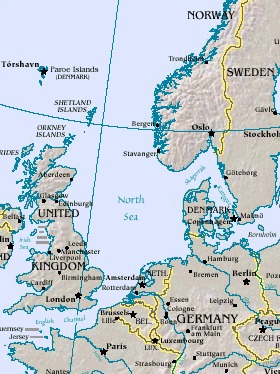Tankerness

Tankerness is a district in the St Andrews parish in Mainland, Orkney, Scotland.[1] A charred hazelnut shell, recovered during the excavations at Longhowe in 2007, has been dated to 6820-6660 BC. [2][3]
Location
Essentially a peninsula, it is about 13 kilometres south-east of Kirkwall and 1 kilometre east of Kirkwall Airport. Tankerness is bounded to the north and west by Inganess Bay, to the east by Deer Sound, and to the south by the A960. Inganess Bay and Deer Sound meet at the prominent headland of Rerwick Head. Loch of Tankerness, which is just under 1 square kilometre (247 acres) in size, lies in the central area. The landscape is more gentle than the hilly terrain to the west and is fertile farmland.[4] Bordering Inganess Bay is the Long Ayre, a kilometer-long gravel tombolo enclosing a tidal pool.
Origin
The origin of the place name is uncertain, but it may derive from the Norse personal name "Tannskári". A "ness" is a promontory.[5]
Jat clans
History
The Orkney Museum is located in Tankerness House, Kirkwall. This town house was acquired by James Baikie of Tankerness in 1641. Baikie was a successful Kirkwall merchant and a descendant of Paul Baikie, navigator to King Håkon IV of Norway. To the south of Loch of Tankerness, is the Hall of Tankerness. This is a 19th-century farm steading on the site of the 12th-century drinking hall of Erling of Tankerness. Nearby is a pier, once used by the herring fleets.
Rerwick Head is the site of a Second World War battery. A variety of concrete buildings remain, including those that housed two six-inch guns salvaged from the battleship HMS Iron Duke. The guns, supported by powerful searchlights, guarded the approaches to Shapinsay Sound.
Prehistory
A charred hazelnut shell, recovered during the excavations at Longhowe in 2007, has been dated to 6820-6660 BC. This pushed back the earliest confirmed date of the occupation of Orkney by 3,000 years.[6][7]
Alistair Moffat[8] writes that ...In this era of migrations Orkney may not have been fought over. Before the early farmers arrived in the period before Knap of Howar was built in c3600 BC, the archipelago was probably not inhabited. Only one tiny scrap of evidence for occupation before that date has ever been found: a charred hazelnut shell at Tankerness was carbon dated to c6000 BC. And that may have been the deposit of a summer expedition from the mainland of Scotland.
Mine Howe, at Toab in the south of Tankerness, is a prehistoric subterranean man-made chamber dug into a large mound. Its walls are lined with stones fitted to form an arch over the cavity and 29 steps lead to a rock floor. These steps descend to a half-landing where they turn back on themselves and a further steps descend to a chamber. This chamber is only about 1.3 metres (4.3 ft) in diameter but is over 4 metres (13 ft) high and has a corbelled roof. The mound is surrounded by a substantial causewayed ditch. The origin of the howe (from Old Norse word haugr meaning barrow) is not perfectly understood, although it is thought to date from the Iron Age. There is some similarity to the well inside the Broch of Gurness.
The Howie of the Manse is a ruined broch on the southern shore of Loch of Tankerness.[9] Further east at Taing of Beeman there is a scattered prehistoric settlement, the remains of which are of unknown provenance.[10]
In 1867 at nearby Groatsetter a fringed woollen hood was discovered lying in peat. It has thought to date from the late Iron Age and may be the oldest textile ever found in Britain.[11]
References
- ↑ Wenham, Shiela "The East Mainland" in Omand (2003) p. 198
- ↑ "Hazelnut shell pushes back date of Orcadian site" (3 November 2007) Stone Pages Archaeo News.
- ↑ "Orkney Archaeology News " Archived 2010-08-13 at the Wayback Machine. Orkneyjar.
- ↑ Wenham, Shiela "The East Mainland" in Omand (2003) p. 198
- ↑ Place names Orkneyjar.
- ↑ "Hazelnut shell pushes back date of Orcadian site" (3 November 2007) Stone Pages Archaeo News.
- ↑ "Orkney Archaeology News " Archived 2010-08-13 at the Wayback Machine. Orkneyjar.
- ↑ Alistair Moffat: The British: A Genetic Journey, Birlinn, 2013,ISBN:9781780270753, p.89-90
- ↑ "The Howie of The Manse" The Megalthic Portal.
- ↑ "Taing of Beeman" The Megalthic Portal.
- ↑ Wenham, Shiela "The East Mainland" in Omand (2003) p. 199

